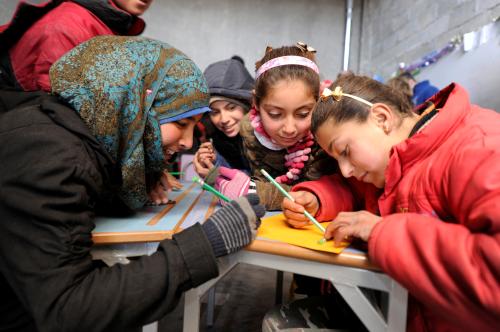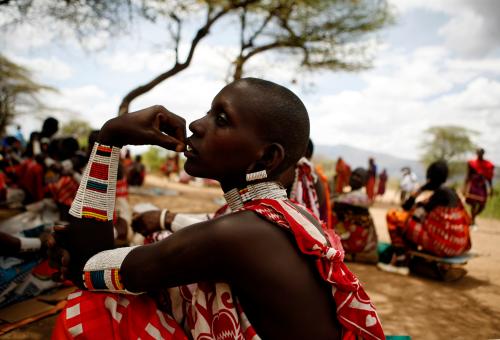Over the last five years, Kenya’s Technical and Vocational Education and Training (TVET) has experienced a series of reforms targeted at expanding youth access to training, improving the quality of training, and better matching of training skills to the demands of the labor market. Engineered by the TVET Act of 2013, the reforms have witnessed the birth of various institutions, including the TVET Authority (TVETA), the Curriculum Development, Assessment, and Certification Council (CDACC), and the Kenyan National Qualifications Authority (KNQA). Among the reform outcomes is the re-assessment and registration of 980 TVET institutions, development of more than 40 competency-based training curricula, and finalization of the Kenya national qualifications framework.
Despite all this, enrollment in TVET has remained relatively low. For instance, there were only 275,000 youth enrolled in around 1,900 TVET institutions in 2017, as compared to over 520,000 thousand youth enrolled in less than 40 universities. Considering that the average training duration for university is four years and TVET’s is two years, the figures are relatively low compared to the more than 700,000 youth exiting the school system each year. This includes those who drop out of primary school, those who complete primary but do not transition to secondary school, and those who either drop out or complete secondary school. It implies then, that annually, at least 350,000 of the youth exiting the school system either remain at home as “not in education, employment, or training” (NEET), or enter the labor market as unskilled workers. To change this, the government has aimed to triple the TVET enrollment to one million by 2019.
Why the low enrollment in TVET?
To understand better what contributes to the low enrollment, a team of 11 staff from ziziAfrique spoke with youth ages 18-25 years in the Kolyonwet location of Kericho County. Kericho is among Kenya’s agriculture hubs, and a leading producer of tea and milk. It also has a high concentration of youth NEET. The team gained four insights that can aid youth reform in Kenya:
1. Targeted communication is essential. There is an information deficit among the youth. Despite the fact that many have access to smart phones, electricity, and even TVs, youth spoken to by the team had not received information on TVET. In fact, none of the youth in the five villages visited were aware of the government sponsorship of TVET and pending deadlines for applications. Strategically placed posters advertising for TVET training opportunities and a government vocational training center within walking distance were not enough. The team learned that targeted communication through word of mouth (via social workers, chiefs, or ward administrators), or through phones, might be more effective in reaching the youth. Even then, information on TVET should be shared in the schools as a potential career path, so that children can associate TVET with life success.
2. Invest in skills acquisition for youth. Kericho’s lush green agricultural environment can be deceptive. Poverty is high among most families, land areas are small, and inequality is high. Increasing household incomes can only happen through innovative value-addition and processing of dairy products, improving farming methods, and upgrading traditional family farming to modern, agribusiness models. Investing in skills acquisition to export skilled labor to other parts of the region and country would certainly be one strategic choice in diminishing the density of youth NEET in Kericho.
3. Establish centers where youth can engage with each other constructively. Creating youth centers could help combat issues with betting activities among males, alcohol abuse, and high prevalence of early pregnancy among girls. At these centers, young people could access information about career options and training, upgrade their digital literacy, access online work, engage in social networking, and increase their skills. Such centers could be established at already existing institutions.
4. Rebrand and reform the TVET program. The team found that many of the youth of Kolyonwet resented how TVET institutions are run like secondary schools—where uniforms, physical punishment, and other restrictions like ‘no phone’ and ‘no leaving the gate’ are enforced. One young man lamented: “After leaving secondary school, one adult proceeds to university where there is no uniform, and is trusted with the responsibility to attend class. The other ends up in TVET, and continues with the childhood confinement of uniform and strict rules.” Another issue is inconvenient timing of TVET programs: many youths need access to afternoon or evening classes at the vocational training center, so that they can work to feed their families during the day. In addition, TVET institutions should focus on solutions to local problems: no TVET institutions in Kericho currently offer training options for agribusiness, for example.
Providing the opportunity for enrollment in TVET is not the same as ensuring that youth actually take advantage of that opportunity. How can we more effectively communicate and engage with these NEET populations of interest? Answering this question is crucial if TVET’s reform efforts are to become a reality in Kenya.
Note: In the Optimizing Assessment for All’s focus on the need for transferable skills for the 21st century, we cannot lose sight of other factors confronting our youth. In this blog from John Mugo of ziziAfrique, an education research center in Kenya, we heard about the disconnect between the opportunity for development of job-specific skills and their uptake by the youth for whom the training is designed.





Commentary
Lessons on youth educational training reform in Kenya
November 13, 2018